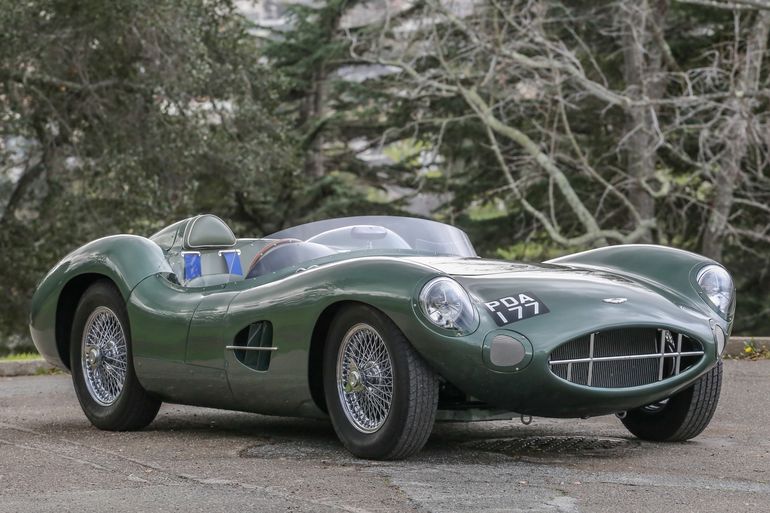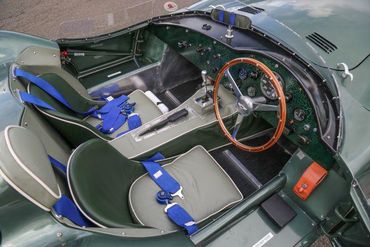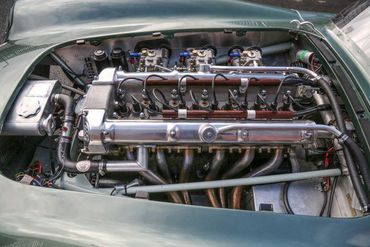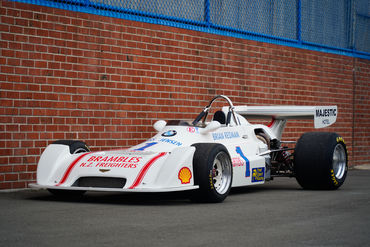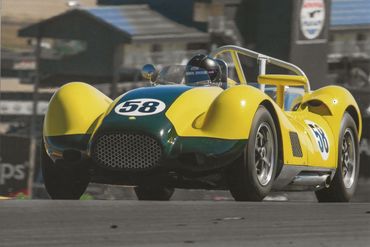Sold
SOLD 12/19
1957 Aston Martin
DBR2 Recreation
A Beautifully Executed Alloy-Bodied DBR2 Recreation with $40,000 in Recent Sorting by Steel Wings. 4.0 Liter DB4 GT Spec Engine with Triple Webers and DB4 GT Gearbox.
- VINLB29076
- Exterior ColorSage Green
- Interior ColorTwo-Tone Green Leather
- MileageTMU
- Engine4.0 Liter DOHC Inline-6
- Engine no.400/4887/SVC
- Transmission4-Speed Manual
- StatusSold
- StockFJ2313
Description
1957 Aston Martin DBR2 Recreation
s/n LB29076, Engine no. 400/4887/SVC
Sage Green with Two-Tone Green Leather Interior
Aston Martin is today one of the most respected marques in the world, a reputation built on decades of sports car competition which reached its peak during the golden age of the sports car. This success was achieved in large part under the leadership of David Brown, who took the helm in 1947. By 1950, Aston Martin announced their intentions to build a car to compete at Le Mans. Eager to establish their reputation as a leading racecar builder, Aston was poised to compete against the likes of Ferrari, Jaguar, and others. The result was the completion of some of the most beautifully constructed sports cars of all time, the DBR1 and DBR2. By 1959, after years of valiant effort against some of the greatest racing cars of all time, Aston Martin would not only win the World Sportscar Championship, it would also win at Le Mans piloted by Carroll Shelby and Roy Salvadori. The evolution of the Le Mans-winning DBR1 was the DBR2, which incorporated a number of improvements, including ultimately a 4.2-liter engine developing well over 300 hp, and scored numerous road-racing victories at the hands of drivers such as Stirling Moss and George Constantine.
With only a scarce few original examples ever assembled by Aston Martin in period, a true DBR2 is among the most valuable and iconic cars of this era. As a result, the only way for a passionate motoring enthusiast to achieve the experience of owning and driving such a great car, is to enjoy the merits of a faithful re-creation. Coupling authenticity and carefully improved engineering, a well-built re-creation can deliver a highly evocative driving experience, while reflecting proper respect to the historic original.
Aston Martin experts Jonathan Dormer and Andrew Soar constructed this particular Aston DBR2 re-creation in the UK. The car is based on an ARA boxed frame racing chassis with alloy coachwork crafted by expert Aston Martin coachbuilders, Chapman Classic Panels. The body was assembled on the chassis incorporating adjustable coil over Koni shock absorbers and DeDion rear suspension. The motor is a 4 liter block assembled to DB4 GT specifications utilizing a brand new Aston Martin twin-plug cylinder head, triple Weber carburetors, and twin distributors. The various castings used employed exact designs to the original DBR2 configuration, complete with the AM symbol cast into the front cam cover section. A DB4 GT gearbox was installed along with a stainless steel exhaust fabricated by Hayward and Scott to complement the GT engine specifications. The unique combined water and oil-cooling radiator (fabricated using factory reference drawings) was fitted with a factory filler cap to match the original design. The fuel cap, boot latch, and bonnet latches were made from solid castings and polished to a fine finish. Inside the car, attention to detail included the use of Smiths instruments, nestled into an authentically finished “cracked green” dash panel. Throughout the car, evidence of careful detailing, polished aluminum features, and thoughtful construction echo the theme of the original wherever possible.
The current owner purchased the car in 2016, engaging Aston Martin experts Jon Clerk and Lance Evans at Steel Wings, Ivyland, PA, to review the car, assess any needs, and significantly improve the car’s authenticity, reliability and performance. Careful attention was given to set proper ride height, make suspension adjustments, and also install new front and rear ORA brake calipers, a new handbrake assembly, new Girling metal brake fluid reservoirs, new rear springs, and new front and rear brake flexible hoses. During the new brake installation, significant engineering improvements were made in the caliper mounts, bearing carriers, machined uprights, and caliper mounts. These improvements not only increased stability under hard braking, they radically improved cornering and braking. Also at this time the gearbox was removed and rebuilt, including the input and output shaft seals. An NOS 3rd gear was installed, as well as a new main shaft and layout spindle. New synchros for 1st, 2nd, 3rd, and 4th gear were also installed during the rebuild. Further work included removing and rebuilding the differential and DeDion assembly in order to ensure proper function. The tubes were carefully fit to the assembly with new specially made spacers for the rose joints. CV joints were washed, greased, and new boots installed. The “Fuel Safe” fuel cell strapping mounts were improved, the oil pressure relief valve was modified for better results, and the charging system was improved with a new voltage regulator. Additional work included changing the throttle linkage geometry and pedal box armature in order to achieve more direct throttle response. This involved several improvements to the mounting of the linkage greatly enhancing both throttle actuation on acceleration and return spring effectiveness on deceleration. The total amount spent on these important engineering improvements exceeded $40,000.
Today, this car presents beautifully, finished in the quintessential Aston Martin metallic sage, which has been properly applied to the handmade alloy coachwork. The paint is glossy throughout and captures the fluidity of the iconic undulating fender lines perfectly, in keeping with the original design. There is some light paint texturing on the lower portions of the rear fenders, more easily seen when studying the car up closely, but not detracting from the overall look of the car. There are a few small chips and scratches from regular use but the overall presentation is stunning. The construction of the body panels is very well done, with excellent fit and finish. The build quality is very high and engineering improvements have been very well executed. Some dimensional improvements were made when compared to the original, most notably a slightly larger body and altered seating position compared to the original, likely to accommodate a greater range of occupant sizes. The visual delight of the car throughout the exterior delivers a very authentic presence with excellent trim, lighting, properly fitted exhaust, clear headlight covers, and beautifully finished 16” chrome wire wheels and triple ear knock-offs shod with Michelin tires.
The interior delivers a handsome combination of racing history and purposeful performance features. Smiths instruments are neatly clustered behind a beautiful wood-rimmed steering wheel adorned with the Aston Martin emblem. The dial faces on the instruments are in excellent condition with clear glass and finely detailed indications, accented against the cracked green dash finish. The two-tone green seats have been properly covered with a period-correct look to the material and forms, nested into the race-trimmed cockpit, the original racing intentions echo in the aluminum finishes, gated gearbox, and purposeful layout. Delightfully accented with a few hints of modern usability, a concealed cup-holder and digital speedometer are just a few indications that this car was built to drive enjoyably while still maintaining its racing heritage. The low windscreen, racing heritage, and vintage finishes really bring a wonderful feel to the interior of the car, which turns any drive into a blast around Le Mans.
Under the hood, the craftsmanship is evident at every corner displaying vintage details from the twin cam casting AM insignia, twin distributors, and Weber carburetors to the beautifully cased 12 plug wire ignition. The engine is purposefully finished with polished cam covers and raw aluminum inner fenders. Contemporary hardware and an electric fan have been appropriately added, allowing modern technology to enhance both reliability and safety. These important improvements are evident when driving this well-balanced and engineered car.
Settling into the driver’s seat, following the start up procedure, the engine fires to life eagerly and settles into a smooth idle with pleasantly raspy exhaust note. The engine delivers excellent throttle response as the twin-cam sound opens up with each tap of the throttle. The driving experience is very satisfying, cohesive, and engaging. Despite the appearance of a full-on race car, the car is actually quite streetable, with a progressive clutch and tractable engine. Even the most confident vintage sports car owners will appreciate the balance and ease exhibited while driving this car. Shifting is smooth with great synchros and good clutch engagement. There is no hesitation from the engine, whether at part throttle around town or when driving more purposefully. The newly-engineered disc brakes deliver great grip, providing ample stopping power smoothly, with uniform tracking. The ride is firm but offers good control and the overall coherence of the package makes this car enjoyable to drive at any speed or intensity.
A masterpiece of automotive design and racing excellence, this Aston Martin DBR2 re-creation is a wonderfully conceived contemporary recreation ready to deliver the history and motoring excellence reminiscent of the unrivaled original. With its recent updates in engineering and improved driving characteristics, this DBR2 offers all the excitement and capability from the glory days of Le Mans and sports car racing, yet is a civilized and usable road car that turns any drive into an occasion.
The above vehicle information is complete and accurate to the best of our knowledge at the time it is posted to this website. Corrections or additional information is always appreciated. All advertised prices exclude government fees and taxes, any finance charges, any dealer document preparation charge, and any emission testing charge. Vehicles are subject to prior sale. All advertised to be true but not guaranteed. We assume no liability for errors or omissions.
Inquire About This Car
Fantasy Junction • 510-653-7555 • 1145 Park Ave, Emeryville, CA 94608
